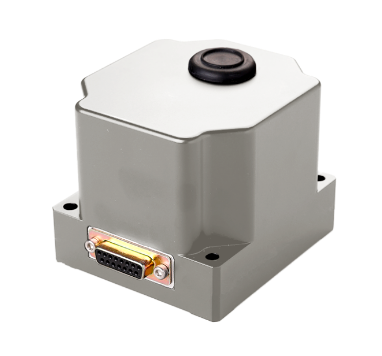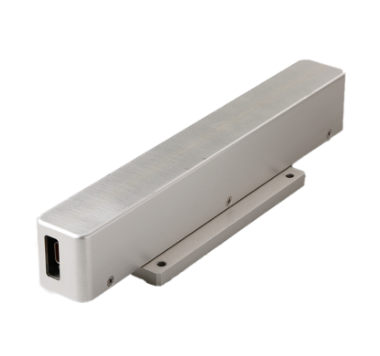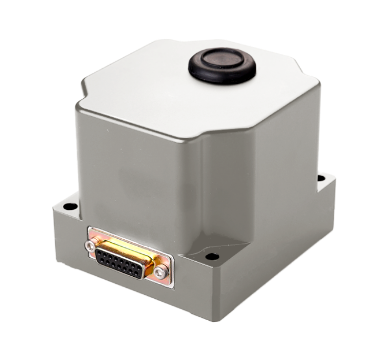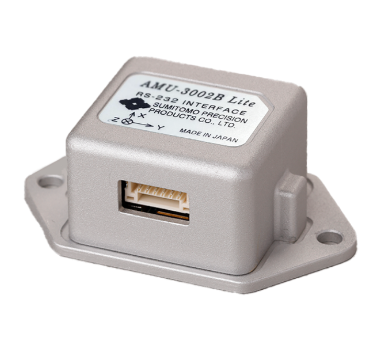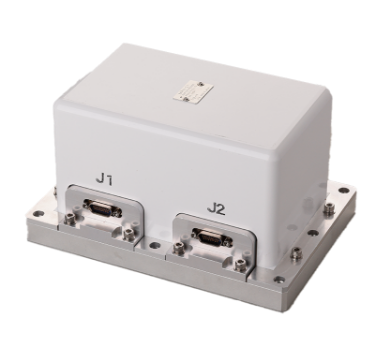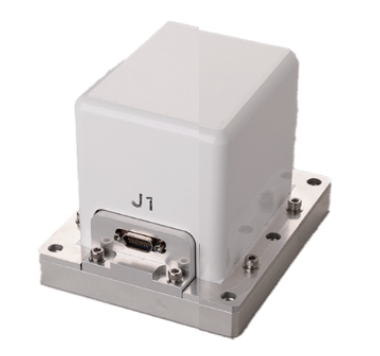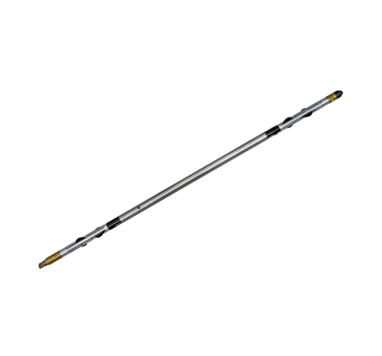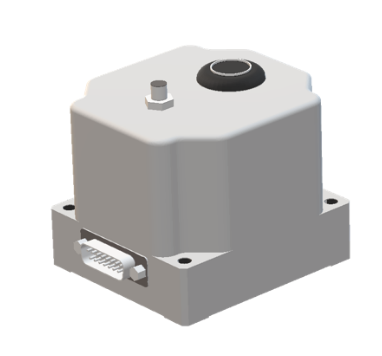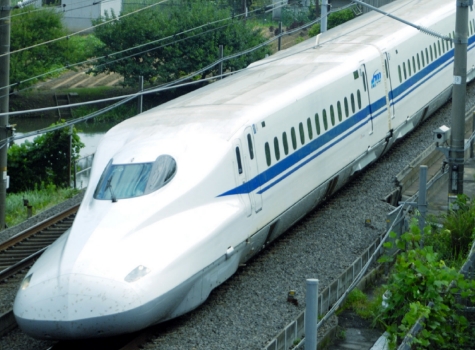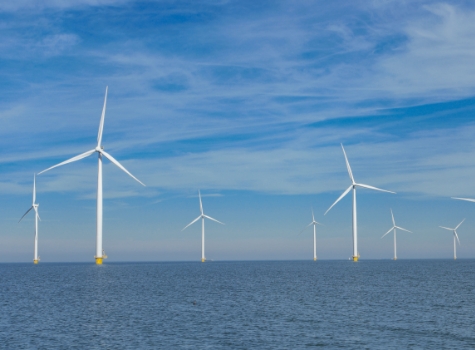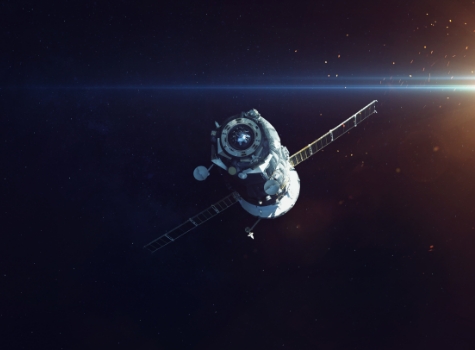The MEMS gyros from Sumitomo Precision Products are what is called the vibration type. There is primary vibration on ring-shaped silicon vibrators in the directions of 0, 90,180 and 270 degrees. When an angular velocity (rotation) is applied in that state, a secondary vibration that is proportional to the angular velocity occurs in the direction that is 45 degrees from the primary vibration. That secondary vibration is read to measure the angular velocity.
FAQ
MEMS
- What is MEMS?
-
MEMS stands for Micro Electro Mechanical Systems. They are devices made by utilizing and advancing the microfabrication technology that has been developed and established for the production of semiconductors on Si wafers. However, instead of two-dimensional integrated circuits (LSI), MEMS devices have a three-dimensional mechanical structure.
Gyro
- What are the operating principles of a MEMS acceleration sensor?
-
The acceleration sensor operates on the principle that the weight suspended on the spring will be displaced. When the object the sensor is attached to accelerates, the suspended weight remains stationary due to inertia. The springs expand and contract and this is detected and the corresponding force is generated. This expansion and contraction is detected by the change in the static capacitance between the movable electrode and opposing fixed electrode in a comb electrode made from silicon.
- What are the characteristics of the gyros from Sumitomo Precision Products?
-
On our gyroscope, a silicon ring type resonator is resonated and vibrated to form an ellipse, and the angular velocity is obtained based on the Coriolis force that is generated there. A typical MEMS gyro has the advantage of being small and inexpensive, but when vibration such as that due to an external impact occurs, the resonant vibration can be disturbed by the external vibration and result in an incorrect output. In contrast with this, when a ring shape is used, the disturbance to the vibration of the ring due to the external vibration is very small, so this type is superior against vibration and impacts.
- Are there any differences between the gyro used in the applied products and the conventional gyro?
-
A characteristic of our gyro is that even when measurements are continued for a long time, the angular deviation is small. In order to give the product that characteristic, inventions unique to our company were used in the MEMS design to reduce various errors.
- In general, aren't the MEMS type vulnerable to vibration shock?
-
The MEMS gyros from our company have a unique ring shape which gives them vibration resisting performance that is of the highest level among MEMS gyros.
- What are the advantages over RLG (Ring Laser Gyros)/FOG (Fiber Optic Gyros)?
-
On RLG (Ring Laser Gyros) and FOG (Fiber Optic Gyros), the angular velocity is detected by using the phase shifts in the light traveling in opposite directions over a certain optical path length. RLG and FOG are very accurate, but they are very complex, so they are relatively large and expensive to manufacture. Semiconductor processes are applied to produce MEMS gyros, so they are very small and can be manufactured in large quantities. As a result of this, it is possible to manufacture them at a lower cost than gyros that use light. In addition, the MEMS structure is very small, and there are no elements that require a large amount of power, such as a laser, so a MEMS gyro can operate at 1/10 the power consumption of a gyro that uses light.
- What is bias?
-
Any type of sensor will have a zero point error for the physical quantity (true value) being sensed. Bias is the error that occurs when the target physical quantity is zero.
- What is drift?
-
Drift refers to the sensor output changing over time. Drift may occur with a time constant of a few seconds to a few minutes after the sensor power supply is turned on, or may occur in units of several months.
- What are the main uses for gyros?
-
This device is used to detect the movement of objects, so it can be used for the purpose of detecting the movement of moving objects. In addition, NorthFinder™ can also detect the azimuth angle in environments where GNSS signals cannot be received, so it can be used as an optimal substitute for GNSS in environments such as underground and underwater.
- Are the gyros used in the applied products made in Japan?
-
The gyros are manufactured within the grounds of the Sumitomo Precision Products Head Office by Silicon Sensing Systems, which is a joint venture with Collins Aerospace.
Applied Products
- How can an angle be measured with a gyro?
-
The gyro outputs the angular velocity, in other words, the angle per unit of time. It is therefore possible to calculate the angle by time integrating the angular velocity. In addition, it can also track fast motion, so it is better at outputting the angle in real time than an inclinometer using an acceleration sensor. Our gyros only have low bias and low drift, so they provide the customer with accurate angles.
- What is the measurement principle for true north?
-
It is obtained by measuring the rotation axis of the Earth with the gyro. True north and the axis of rotation are almost the same.
- Is true north different from magnetic north?
-
Magnetic north is obtained by measuring geomagnetism with a magnetic sensor. In the central area of Japan, it differs from true north by about 7 degrees.
- What is attitude angle?
-
The attitude angle is the inclination of the object relative to the plane containing the X and Y axes perpendicular to the Earth's gravitational axis (Z axis).
- What is azimuth angle?
-
The azimuth angle is the angle about the Earth's gravitational axis, which is perpendicular to the XY plane. There is the relative azimuth angle, in which the initial azimuth angle the equipment is pointing in when it is switched on is taken as zero degrees, and the absolute azimuth angle, in which the true north (North Pole) direction is taken as zero degrees. All products can measure the relative azimuth angle, but the NorthFinder™ products can also measure the absolute azimuth angle.
- What is IMU?
-
IMU stands for Inertial Measurement Unit, which is a device that outputs the angular velocity and acceleration of the X, Y, and Z3 axes. Most products compensate for X, Y and Z axis orthogonal deviation and deviation due to temperature.
- What is VG?
-
VG stands for Vertical Gyro, which is a device that outputs attitude angle and relative azimuth angle.
- What is AHRS?
-
AHRS stands for Attitude Heading Reference System, which is a device that outputs attitude angle and absolute azimuth angle.
- What is INS?
-
INS stands for Inertial Navigation System, which is a device that outputs speed and travel distance in addition to the functions of AHRS. INS devices include pure inertia INS and GNSS assisted INS.
- What is the difference to products equipped with an RLG (Ring Laser Gyro) or FOG (Fiber Optic Gyro)?
-
On RLG (Ring Laser Gyros) and FOG (Fiber Optic Gyros), the angular velocity is detected by using the phase shifts in the light traveling in opposite directions over a certain optical path length. RLG and FOG are very accurate, but they are very complex, so they are relatively large and expensive to manufacture. MEMS gyros apply semiconductor processes, so they are very small and mass production is possible. As a result of this, it is possible to manufacture them at a lower cost than gyros that use light. In addition, the MEMS structure is very small, and there are no elements that require a large amount of power, such as a laser, so a MEMS gyro can operate at 1/10 the power consumption of a gyro that uses light.
- Can it be connected to a computer?
-
Depending on the output format of the product, connection is possible if items such as a serial communication board are prepared. If you have any questions, please contact us via the inquiry form.
- Are there any accompanying applications?
-
Some have been prepared for some products.
- Can it be equipped with GNSS?
-
If the substrate components of the GNSS and the gyros are separated, they can be housed in the same housing.
- There are small products on the market that have an IMU function in one chip. This product seems big.
-
Even in a product that has an IMU function in one chip, the X, Y, and Z axis elements are arranged independently inside the chip, and the accuracy of the Z axis element in particular is relatively poor. In our gyros, in order to give the products their characteristic high accuracy in any position, the IMU is composed of independent gyros with the same structure in all of the X, Y, and Z axes. This makes the size larger than IMU in one chip, but they are characterized by high accuracy.
- Is periodic calibration necessary?
-
This may be necessary, depending on the use. For details, please contact us via the inquiry form.
- Can it be made waterproof?
-
Basically, our products do not have a waterproof structure, so the customer should take the waterproofing action necessary.
- Can it be used at the South Pole?
-
Use is not possible near to the North Pole or the South Pole because the error becomes large.
- Can it be used overseas?
-
Use overseas is possible.
- What happens if it is operated without a period for warming up?
-
MEMS gyros have an initial output change that is called warm-up drift. Each product has an output signal that indicates the stable state after the warm-up, so please use it as a guide.
- What parameters can be output?
-
Various information is output in addition to angular velocity, acceleration, attitude angle and azimuth angle. Please check the product data sheet for details.
- Will ISO documents related to calibration be issued?
-
ISO documents are not issued for the calibration unique to our company.
- What are the recommended or specified frequency and contents of calibrations?
-
This varies depending on the use. For details, please contact us via the inquiry form.
- Are there any official standards (such as ISO and IEC) that each individual product has cleared?
-
Please check the data sheet for each product.
- What happens if the initial alignment is performed on a platform that is shaking rather than static?
-
It is not possible to measure the axis of rotation of the Earth with the gyro, so we ask that it is established in a stationary state.
- How are the gyros and applied products from Sumitomo Precision Products superior to those from other companies and what are the advantages of installing them?
-
On our gyroscope, a silicon ring type resonator is resonated and vibrated to form an ellipse, and the angular velocity is obtained based on the Coriolis force that is generated there. A typical MEMS gyro has the advantage of being small and inexpensive, but when vibration such as that due to an external impact occurs, the resonant vibration can be disturbed by the external vibration and result in an incorrect output. In contrast with this, when a ring shape is used, the disturbance to the vibration of the ring due to the external vibration is very small, so this type is superior against vibration and impacts. In addition, on the applied products that use the gyro, in order to make the most of the characteristics of a gyro, in addition to the characteristics explained above, the products are also characterized by the use of proprietary algorithms of our company that mean that even with a MEMS gyro, it is possible to detect true north by measuring the rotational angular velocity of the Earth. A characteristic obtained by using the MEMS type is that the power consumed is 1/10 that consumed by other gyrocompasses. This is a great advantage, particularly when a product is powered by a battery.
- What are the advantages of combining GNSS and gyro applied products?
-
Positioning by GNSS can only be performed when a signal is received from GNSS satellites. When positioning is performed by GNSS alone, positioning becomes impossible when the signals from satellites are interrupted, such as where there are many obstacles in an area of high-rise buildings, and where the signal is interrupted underground and in tunnels.
By performing the calculation processing in combination with information from various sensors such as the gyro and acceleration sensors, it becomes possible to perform the positioning with high accuracy, even when in an environment where it would be difficult to continue positioning by GNSS alone. - Can the value measured by the gyro be sent via Bluetooth or Wi-Fi instead of a wired connection?
-
It is possible. However, the communication distance specified by each radio standard is the maximum value, and the distance will also vary depending on the actual situation.
- What should be done if the transmission distance from the gyro to the monitoring point is very long, for example, several kilometers?
-
If a signal is to be transmitted, there is the method of converting it to light by using a photocoupler. However, a photocoupler cannot transmit power.
One of the advantages of using a photocoupler is that it is not necessary to have a common GND level, so operation is possible even if the sensor head side and the monitor side are different power supply systems. However, there are limits to the frequencies that can be followed by a photocoupler, so caution is required when transmitting high-speed digital signals. We do not think there will be any problems with the transmission of the azimuth angle, attitude angle, angular velocity, acceleration and position. - Air mobility photographs are used on the website and in catalogs. Is this something that has already been adopted by a particular company? Also, does it have type approval?
-
The product is currently under development and has not yet been adopted, but the development is being advanced with the intention of obtaining type certification.
- Is it possible to borrow samples of applied products?
-
Coordination regarding the rental period is required, but the renting of samples is possible.
Others
- Is it possible to rent a demonstration machine for the product?
-
Rental is available upon request.
- Can it be purchased overseas?
-
Purchasing overseas is possible.
- If it breaks down, will you repair it?
-
Our company will conduct the repairs if we judge that repair is possible.
- Can it be used for defense purposes?
-
Please check the data sheet and make your own judgment on this.
- Is it subject to export control?
-
This product does not correspond to navigation equipment or a gyroscope under the Wassenaar Arrangement and is not subject to export regulations, but proper export control by the customer is necessary. It is also an ITAR-free product.
- What are the delivery period and price?
-
Please contact us via the inquiry form.
- Is customization available?
-
Please consult us.
- Where should we contact if there is a failure or it feels like the operation is not normal?
-
Either contact your sales representative directly or contact us via the inquiry form.


